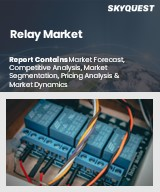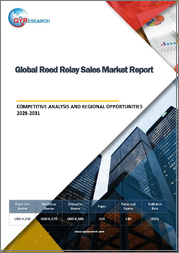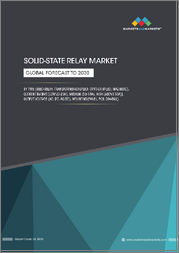
|
시장보고서
상품코드
1503407
전기기계식 릴레이 시장 예측(-2030년) : 유형, 재료, 판매채널, 용도, 최종사용자, 지역별 세계 분석Electromechanical Relay Market Forecasts to 2030 - Global Analysis By Type (Plug-in Relay, Power Relay, Signal Relay, Automotive Relay, Solid State Relays (SSRs) and Other Types), Material, Sales Channel, Application, End User and By Geography |
||||||
Stratistics MRC에 따르면 세계의 전기기계식 릴레이 시장은 2024년에 123억 달러를 차지하고 예측 기간 중 CAGR은 10.0%로 성장하며, 2030년에는 218억 달러에 달할 전망입니다.
전기 기계식 릴레이는 전자석에 의해 작동하여 하나 이상의 회로를 개폐하는 스위치입니다. 코일, 전기자, 스프링 및 접점으로 구성됩니다. 코일에 전류가 흐르면 자기장이 발생하여 전기자가 움직이고 접점이 열리고 닫힙니다. 이를 통해 릴레이는 저전력 신호로 고전력 회로를 제어할 수 있으며, 자동화, IT 및 통신, 전기 보호 시스템 등 다양한 용도에 필수적인 역할을 합니다.
자동화에 대한 수요 증가
기술의 발전과 함께 시장에서는 자동화에 대한 수요가 급증하고 있습니다. 이러한 급증은 산업 전반에 걸쳐 효율성, 신뢰성 및 비용 효율성을 추구하기 위한 노력의 결과입니다. 제조업에서 운송업에 이르기까지 기업은 자동 중계 시스템을 통합하여 업무를 간소화하고 생산성을 향상시키고 있습니다. 또한 IoT와 인더스트리 4.0의 발전과 함께 상호 연결 시스템에 원활하게 통합될 수 있는 지능형 릴레이 솔루션의 필요성이 이러한 수요를 더욱 촉진하여 자동 릴레이 기술로의 큰 전환을 보여주고 있습니다.
제한된 속도 및 스위칭 주파수
릴레이는 신뢰성과 견고성을 제공하지만, 기계적 특성으로 인해 응답 시간과 스위칭 속도에 제약이 있습니다. 이러한 한계는 첨단 자동화 및 통신과 같이 고속 및 고주파 동작이 필요한 용도에서 더욱 두드러지게 나타납니다. 솔리드 스테이트 부품을 통합한 하이브리드 솔루션과 같은 릴레이 성능 향상을 위한 기술 혁신은 이러한 문제를 해결하고 현대의 급변하는 산업과의 호환성을 보장하기 위해 등장하고 있습니다.
간단한 조작과 낮은 유지보수
시장에서는 작동이 간편하고 유지보수가 적은 솔루션에 대한 수요가 급증하고 있습니다. 제조업체들은 이 두 가지 측면을 모두 만족시키는 혁신적인 릴레이 시스템을 개발하여 이에 대응하고 있습니다. 이러한 릴레이는 직관적인 설계와 내구성이 뛰어난 컴포넌트를 통합하여 번거롭지 않은 작동과 최소한의 유지보수를 보장합니다. 산업계가 효율성과 비용 효율성을 점점 더 중요시하는 가운데, 이러한 솔루션은 다양한 분야에서 필수적인 요소로 자리 잡으며 시장 성장을 가속하고 있습니다.
솔리드 스테이트 릴레이와의 경쟁
고체 상태 릴레이는 전기 기계식 릴레이 시장에 강력한 문제에 직면하고 있습니다. 기존 릴레이와 달리 빠른 스위칭 속도, 긴 수명, 전자기 간섭 감소 등 여러 가지 장점이 있습니다. 또한 SSR은 더 작고 조용하게 작동하기 때문에 다양한 용도에 이상적입니다. 이러한 요인들로 인해 경쟁이 치열해지고 있으며, 전기기계식 릴레이 제조업체들은 점점 더 많은 인기를 얻고 있는 가운데 시장에서의 관련성을 유지하기 위해 제품을 혁신하고 강화해야 합니다.
COVID-19의 영향 :
COVID-19는 전기기계식 릴레이 시장에 큰 영향을 미치고 있습니다. 공급망 중단, 인력 부족, 생산 능력 감소로 인해 릴레이 제조업체는 생산 지연과 비용 증가를 겪고 있습니다. 또한 산업 활동 감소와 프로젝트 연기 등으로 인해 자동차, 항공우주, 산업 자동화 등 다양한 분야의 릴레이 수요가 감소하고 있습니다. 그러나 통신 인프라와 헬스케어 분야에 대한 관심이 높아지면서 시장에 회복력을 불어넣고 있습니다.
예측 기간 중 자동차 릴레이 분야가 최대 규모일 것으로 예상됩니다.
예측 기간 중 자동차 릴레이가 가장 큰 시장을 형성할 것으로 예상됩니다. 이러한 릴레이는 자동차의 전기 회로를 관리하고 조명, 난방, 공조 등 다양한 시스템의 효율적인 작동을 보장하는 데 매우 중요한 역할을 합니다. 최근 자동차의 첨단 전자 기능 통합으로 인해 자동차 릴레이에 대한 수요는 지속적으로 증가하고 있습니다. 신뢰성, 내구성, 다양한 차량 아키텍처와의 호환성 등의 요인이 이 틈새 시장 부문경쟁 구도를 형성하고 있습니다.
예측 기간 중 가장 높은 CAGR을 나타낼 것으로 예상되는 산업 부문
산업 부문은 예측 기간 중 가장 높은 CAGR을 나타낼 것으로 예상됩니다. 자동화의 발전과 신뢰할 수 있는 스위칭 솔루션에 대한 요구가 시장 확대의 원동력이 되고 있습니다. 자동차에서 항공우주에 이르기까지 전기 기계식 릴레이는 기계 및 장비의 원활한 작동을 보장하는 데 중요한 역할을 합니다. 이러한 산업 환경의 급격한 변화는 현대 엔지니어링 환경에서 전기기계식 계전기가 매우 중요한 위치를 차지하고 있으며, 전 세계 전기 시스템에 필수적인 컴포넌트로 자리매김하고 있음을 강조합니다.
가장 큰 점유율을 차지하는 지역
예측 기간 중 북미가 가장 큰 시장 점유율을 차지할 것으로 예상됩니다. 기술 발전에 따라 이러한 릴레이는 더욱 정교해지고 효율성과 신뢰성이 향상되고 있습니다. 자동화의 확산과 신뢰할 수 있는 스위칭 솔루션의 필요성이 시장 성장을 더욱 촉진하고 있습니다. 또한 안전 및 신뢰성에 대한 엄격한 규제 요건도 이 지역의 전기기계식 릴레이에 대한 수요를 촉진하고 있습니다.
CAGR이 가장 높은 지역 :
예측 기간 중 아시아태평양은 가장 높은 CAGR을 유지할 것으로 예상됩니다. 이 지역의 급속한 도시화와 인프라 개발 프로젝트가 배전, 운송 시스템, 빌딩 자동화 등의 분야에서 전기기계식 릴레이에 대한 수요를 촉진하고 있습니다. 태양광 및 풍력발전과 같은 재생 에너지 발전에 대한 관심이 증가함에 따라 발전 및 배전 시스템에서 전기기계식 릴레이에 대한 수요가 증가하고 있습니다.
무료 커스터마이징 서비스
이 보고서를 구독하는 고객은 다음과 같은 무료 맞춤화 옵션 중 하나를 사용할 수 있습니다.
- 기업 개요
- 추가 시장 기업의 종합적인 프로파일링(최대 3사)
- 주요 기업의 SWOT 분석(최대 3사)
- 지역 세분화
- 고객의 관심에 따른 주요 국가별 시장 추정치, 예측, CAGR(주: 타당성 확인에 따라 다름)
- 경쟁사 벤치마킹
- 제품 포트폴리오, 지역적 입지, 전략적 제휴를 기반으로 한 주요 기업 벤치마킹
목차
제1장 주요 요약
제2장 서문
- 개요
- 이해관계자
- 조사 범위
- 조사 방법
- 데이터 마이닝
- 데이터 분석
- 데이터 검증
- 조사 어프로치
- 조사 정보원
- 1차 조사 정보원
- 2차 조사 정보원
- 전제조건
제3장 시장 동향 분석
- 촉진요인
- 억제요인
- 기회
- 위협
- 용도 분석
- 최종사용자 분석
- 신흥 시장
- COVID-19의 영향
제4장 Porter's Five Forces 분석
- 공급 기업의 교섭력
- 구매자의 교섭력
- 대체품의 위협
- 신규 진출업체의 위협
- 경쟁 기업간 경쟁 관계
제5장 세계의 전기기계식 릴레이 시장 : 유형별
- 플러그인 릴레이
- 파워 릴레이
- 신호 릴레이
- 자동차용 릴레이
- 솔리드 스테이트 릴레이(SSR)
- 기타 유형
제6장 세계의 전기기계식 릴레이 시장 : 재료별
- 은합금
- 금도금
- 구리
- 바이메탈 스트립
- 코일 와이어
제7장 세계의 전기기계식 릴레이 시장 : 판매채널별
- 직접 판매
- 판매 대리점
- 온라인 판매
- 소매업체
제8장 세계의 전기기계식 릴레이 시장 : 용도별
- 공장 자동화
- 모터 제어
- 온도 컨트롤러
- 철도 경로와 신호
- 무선 테크놀러지
- 기타 용도
제9장 세계의 전기기계식 릴레이 시장 : 최종사용자별
- 자동차
- 산업
- 통신
- 항공우주 및 방위
- 가전
- 헬스케어
- 기타 최종사용자
제10장 세계의 전기기계식 릴레이 시장 : 지역별
- 북미
- 미국
- 캐나다
- 멕시코
- 유럽
- 독일
- 영국
- 이탈리아
- 프랑스
- 스페인
- 기타 유럽
- 아시아태평양
- 일본
- 중국
- 인도
- 호주
- 뉴질랜드
- 한국
- 기타 아시아태평양
- 남미
- 아르헨티나
- 브라질
- 칠레
- 기타 남미
- 중동 및 아프리카
- 사우디아라비아
- 아랍에미리트
- 카타르
- 남아프리카공화국
- 기타 중동 및 아프리카
제11장 주요 발전
- 계약, 파트너십, 협업, 합병사업
- 인수합병
- 신제품 발매
- 사업 확대
- 기타 주요 전략
제12장 기업 프로파일링
- Siemens AG
- ABB Ltd.
- TE Connectivity Ltd.
- Schneider Electric SE
- Omron Corporation
- Honeywell International Inc.
- Fujitsu Ltd.
- Panasonic Corporation
- Littelfuse, Inc.
- Rockwell Automation, Inc.
- General Electric Company
- Phoenix Contact GmbH & Co. KG
- IDEC Corporation
- Picker Components
- NTE Electronics, Inc.
- Eaton Corporation
- Comus International
According to Stratistics MRC, the Global Electromechanical Relay Market is accounted for $12.3 billion in 2024 and is expected to reach $21.8 billion by 2030 growing at a CAGR of 10.0% during the forecast period. An electromechanical relay is a switch operated by an electromagnet to open or close one or multiple circuits. It consists of a coil, armature, spring, and contacts. When an electric current passes through the coil, it generates a magnetic field that moves the armature, which in turn opens or closes the contacts. This allows the relay to control high power circuits with a low power signal, making it essential for various applications in automation, telecommunications, and electrical protection systems.
Market Dynamics:
Driver:
Increased demand for automation
As the technological landscape evolves, there's a burgeoning demand for automation within the market. This surge is driven by the quest for efficiency, reliability, and cost-effectiveness across industries. From manufacturing to transportation, businesses are integrating automated relay systems to streamline operations and enhance productivity. Moreover, with the advancement of IoT and Industry 4.0, the need for intelligent relay solutions capable of seamless integration into interconnected systems further propels this demand, marking a significant shift towards automated relay technologies.
Restraint:
Limited speed and switching frequency
While relays offer reliability and robustness, their mechanical nature imposes constraints on response times and switching rates. This limitation becomes pronounced in applications requiring rapid, high-frequency operations, such as advanced automation and telecommunications. Innovations aimed at enhancing relay performance, such as hybrid solutions integrating solid-state components, are emerging to address these challenges, ensuring compatibility with modern, fast-paced industries.
Opportunity:
Simple operation and low maintenance
In the market, demand is surging for solutions that offer simplicity in operation and low maintenance requirements. Manufacturers are responding by developing innovative relay systems that excel in both aspects. These relays incorporate intuitive designs and durable components, ensuring hassle-free operation and minimal upkeep. As industries increasingly prioritize efficiency and cost-effectiveness, such solutions are becoming integral across various sectors, driving growth in the market.
Threat:
Competition from solid-state relays
Solid-state relays present a formidable challenge to the electromechanical relay market. Unlike traditional relays, they offer numerous advantages including faster switching speeds, longer lifespan, and reduced electromagnetic interference. Additionally, SSRs are more compact and operate silently, making them ideal for various applications. These factors have intensified competition, prompting electromechanical relay manufacturers to innovate and enhance their products to maintain market relevance amidst the growing popularity.
Covid-19 Impact:
The COVID-19 pandemic has significantly impacted the electromechanical relay market. Supply chain disruptions, labor shortages, and reduced manufacturing capacity have led to production delays and increased costs for relay manufacturers. Additionally, decreased industrial activities and project postponements have dampened demand for relays in various sectors, including automotive, aerospace, and industrial automation. However, the growing emphasis on telecommunication infrastructure and the healthcare sector has provided some resilience to the market.
The automotive relay segment is expected to be the largest during the forecast period
The automotive relay is expected to be the largest during the forecast period. These relays play a pivotal role in managing electrical circuits within vehicles, ensuring efficient operation of various systems like lighting, heating, and air conditioning. With the increasing integration of advanced electronic features in modern automobiles, the demand for automotive relays continues to surge. Factors such as reliability, durability, and compatibility with diverse vehicle architectures are shaping the competitive landscape within this niche market segment.
The industrial segment is expected to have the highest CAGR during the forecast period
The industrial segment is expected to have the highest CAGR during the forecast period. Advancements in automation, coupled with the need for reliable switching solutions, fuel the market expansion. From automotive to aerospace, electromechanical relays play a crucial role in ensuring seamless operation of machinery and equipment. This surge in industrial applications underscores the pivotal position of electromechanical relays in modern engineering landscapes, solidifying their status as indispensable components in electrical systems worldwide.
Region with largest share:
North America is projected to hold the largest market share during the forecast period driven by increasing demand across various industries. With advancements in technology, these relays are becoming more sophisticated, offering improved efficiency and reliability. Factors such as the growing adoption of automation and the need for reliable switching solutions further fuel market growth. Additionally, stringent regulatory requirements regarding safety and reliability bolster the demand for electromechanical relays in the region.
Region with highest CAGR:
Asia Pacific is projected to hold the highest CAGR over the forecast period. Rapid urbanization and infrastructure development projects across the region are driving the demand for electromechanical relays in applications such as power distribution, transportation systems, and building automation. With the increasing focus on renewable energy sources such as solar and wind power, there is a growing demand for electromechanical relays in power generation and distribution systems.
Key players in the market
Some of the key players in Electromechanical Relay market include Siemens AG, ABB Ltd., TE Connectivity Ltd., Schneider Electric SE, Omron Corporation, Honeywell International Inc., Fujitsu Ltd., Panasonic Corporation, Littelfuse, Inc., Rockwell Automation, Inc., General Electric Company, Phoenix Contact GmbH & Co. KG, IDEC Corporation, Picker Components, NTE Electronics, Inc., Eaton Corporation and Comus International.
Key Developments:
In March 2024, Siemens has developed one of the world's most innovative circuit protection devices with cutting-edge electronic switching technology. SENTRON ECPD (Electronic Circuit Protection Device) electronically switches off circuit faults if errors occur and, if necessary, trips the mechanical isolating contact downstream.
In August 2023, Siemens has launched a new generation of line monitoring relays. The SIRIUS 3UG5 line monitoring relays combine proven technology with new functions and applications. The relays are the easiest way to monitor standards-compliant grid stability and quality, ensuring proper system operation and a long service life of components such as motors or compressors.
Types Covered:
- Plug-in Relay
- Power Relay
- Signal Relay
- Automotive Relay
- Solid State Relays (SSRs)
- Other Types
Materials Covered:
- Silver Alloy
- Gold-Plated
- Copper
- Bimetallic Strips
- Coil Wire
Sales Channels Covered:
- Direct Sales
- Distributors
- Online Sales
- Retailers
Applications Covered:
- Factory Automation
- Motor Controls
- Temperature Controllers
- Railways Routing and Signaling
- Wireless Technology
- Other Applications
End Users Covered:
- Automotive
- Industrial
- Telecommunication
- Aerospace and Defense
- Consumer Electronics
- Healthcare
- Other End Users
Regions Covered:
- North America
- US
- Canada
- Mexico
- Europe
- Germany
- UK
- Italy
- France
- Spain
- Rest of Europe
- Asia Pacific
- Japan
- China
- India
- Australia
- New Zealand
- South Korea
- Rest of Asia Pacific
- South America
- Argentina
- Brazil
- Chile
- Rest of South America
- Middle East & Africa
- Saudi Arabia
- UAE
- Qatar
- South Africa
- Rest of Middle East & Africa
What our report offers:
- Market share assessments for the regional and country-level segments
- Strategic recommendations for the new entrants
- Covers Market data for the years 2022, 2023, 2024, 2026, and 2030
- Market Trends (Drivers, Constraints, Opportunities, Threats, Challenges, Investment Opportunities, and recommendations)
- Strategic recommendations in key business segments based on the market estimations
- Competitive landscaping mapping the key common trends
- Company profiling with detailed strategies, financials, and recent developments
- Supply chain trends mapping the latest technological advancements
Free Customization Offerings:
All the customers of this report will be entitled to receive one of the following free customization options:
- Company Profiling
- Comprehensive profiling of additional market players (up to 3)
- SWOT Analysis of key players (up to 3)
- Regional Segmentation
- Market estimations, Forecasts and CAGR of any prominent country as per the client's interest (Note: Depends on feasibility check)
- Competitive Benchmarking
- Benchmarking of key players based on product portfolio, geographical presence, and strategic alliances
Table of Contents
1 Executive Summary
2 Preface
- 2.1 Abstract
- 2.2 Stake Holders
- 2.3 Research Scope
- 2.4 Research Methodology
- 2.4.1 Data Mining
- 2.4.2 Data Analysis
- 2.4.3 Data Validation
- 2.4.4 Research Approach
- 2.5 Research Sources
- 2.5.1 Primary Research Sources
- 2.5.2 Secondary Research Sources
- 2.5.3 Assumptions
3 Market Trend Analysis
- 3.1 Introduction
- 3.2 Drivers
- 3.3 Restraints
- 3.4 Opportunities
- 3.5 Threats
- 3.6 Application Analysis
- 3.7 End User Analysis
- 3.8 Emerging Markets
- 3.9 Impact of Covid-19
4 Porters Five Force Analysis
- 4.1 Bargaining power of suppliers
- 4.2 Bargaining power of buyers
- 4.3 Threat of substitutes
- 4.4 Threat of new entrants
- 4.5 Competitive rivalry
5 Global Electromechanical Relay Market, By Type
- 5.1 Introduction
- 5.2 Plug-in Relay
- 5.3 Power Relay
- 5.4 Signal Relay
- 5.5 Automotive Relay
- 5.6 Solid State Relays (SSRs)
- 5.7 Other Types
6 Global Electromechanical Relay Market, By Material
- 6.1 Introduction
- 6.2 Silver Alloy
- 6.3 Gold-Plated
- 6.4 Copper
- 6.5 Bimetallic Strips
- 6.6 Coil Wire
7 Global Electromechanical Relay Market, By Sales Channel
- 7.1 Introduction
- 7.2 Direct Sales
- 7.3 Distributors
- 7.4 Online Sales
- 7.5 Retailers
8 Global Electromechanical Relay Market, By Application
- 8.1 Introduction
- 8.2 Factory Automation
- 8.3 Motor Controls
- 8.4 Temperature Controllers
- 8.5 Railways Routing and Signaling
- 8.6 Wireless Technology
- 8.7 Other Applications
9 Global Electromechanical Relay Market, By End User
- 9.1 Introduction
- 9.2 Automotive
- 9.3 Industrial
- 9.4 Telecommunication
- 9.5 Aerospace and Defense
- 9.6 Consumer Electronics
- 9.7 Healthcare
- 9.8 Other End Users
10 Global Electromechanical Relay Market, By Geography
- 10.1 Introduction
- 10.2 North America
- 10.2.1 US
- 10.2.2 Canada
- 10.2.3 Mexico
- 10.3 Europe
- 10.3.1 Germany
- 10.3.2 UK
- 10.3.3 Italy
- 10.3.4 France
- 10.3.5 Spain
- 10.3.6 Rest of Europe
- 10.4 Asia Pacific
- 10.4.1 Japan
- 10.4.2 China
- 10.4.3 India
- 10.4.4 Australia
- 10.4.5 New Zealand
- 10.4.6 South Korea
- 10.4.7 Rest of Asia Pacific
- 10.5 South America
- 10.5.1 Argentina
- 10.5.2 Brazil
- 10.5.3 Chile
- 10.5.4 Rest of South America
- 10.6 Middle East & Africa
- 10.6.1 Saudi Arabia
- 10.6.2 UAE
- 10.6.3 Qatar
- 10.6.4 South Africa
- 10.6.5 Rest of Middle East & Africa
11 Key Developments
- 11.1 Agreements, Partnerships, Collaborations and Joint Ventures
- 11.2 Acquisitions & Mergers
- 11.3 New Product Launch
- 11.4 Expansions
- 11.5 Other Key Strategies
12 Company Profiling
- 12.1 Siemens AG
- 12.2 ABB Ltd.
- 12.3 TE Connectivity Ltd.
- 12.4 Schneider Electric SE
- 12.5 Omron Corporation
- 12.6 Honeywell International Inc.
- 12.7 Fujitsu Ltd.
- 12.8 Panasonic Corporation
- 12.9 Littelfuse, Inc.
- 12.10 Rockwell Automation, Inc.
- 12.11 General Electric Company
- 12.12 Phoenix Contact GmbH & Co. KG
- 12.12 IDEC Corporation
- 12.14 Picker Components
- 12.15 NTE Electronics, Inc.
- 12.16 Eaton Corporation
- 12.17 Comus International



















